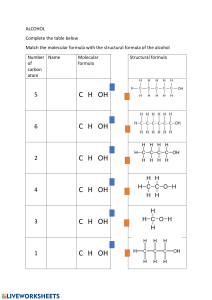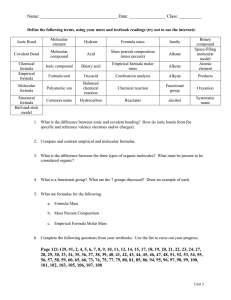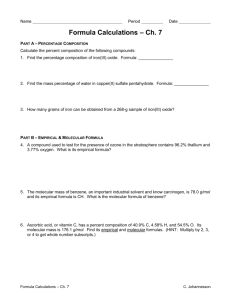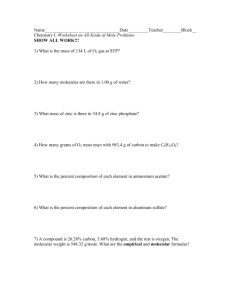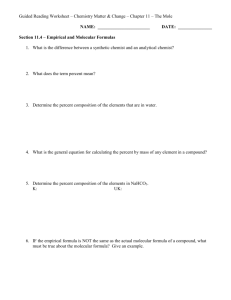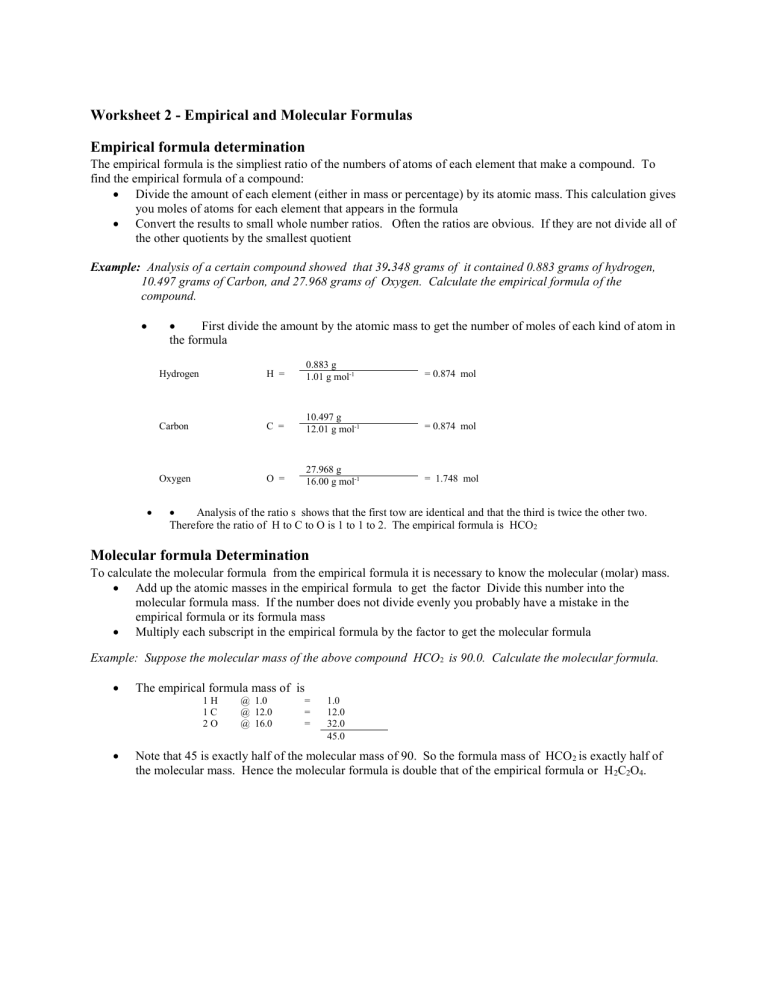
Worksheet 2 - Empirical and Molecular Formulas Empirical formula determination The empirical formula is the simpliest ratio of the numbers of atoms of each element that make a compound. To find the empirical formula of a compound: Divide the amount of each element (either in mass or percentage) by its atomic mass. This calculation gives you moles of atoms for each element that appears in the formula Convert the results to small whole number ratios. Often the ratios are obvious. If they are not divide all of the other quotients by the smallest quotient Example: Analysis of a certain compound showed that 39.348 grams of it contained 0.883 grams of hydrogen, 10.497 grams of Carbon, and 27.968 grams of Oxygen. Calculate the empirical formula of the compound. First divide the amount by the atomic mass to get the number of moles of each kind of atom in the formula Hydrogen H = 0.883 g 1.01 g mol-1 = 0.874 mol Carbon C = 10.497 g 12.01 g mol-1 = 0.874 mol Oxygen O = 27.968 g 16.00 g mol-1 = 1.748 mol Analysis of the ratio s shows that the first tow are identical and that the third is twice the other two. Therefore the ratio of H to C to O is 1 to 1 to 2. The empirical formula is HCO2 Molecular formula Determination To calculate the molecular formula from the empirical formula it is necessary to know the molecular (molar) mass. Add up the atomic masses in the empirical formula to get the factor Divide this number into the molecular formula mass. If the number does not divide evenly you probably have a mistake in the empirical formula or its formula mass Multiply each subscript in the empirical formula by the factor to get the molecular formula Example: Suppose the molecular mass of the above compound HCO 2 is 90.0. Calculate the molecular formula. The empirical formula mass of is 1H 1C 2O @ 1.0 @ 12.0 @ 16.0 = = = 1.0 12.0 32.0 45.0 Note that 45 is exactly half of the molecular mass of 90. So the formula mass of HCO 2 is exactly half of the molecular mass. Hence the molecular formula is double that of the empirical formula or H 2C2O4. Worksheet 2- Empirical and Molecular Formula Calculations 1. A certain compound contains 4.0 g of calcium and 7.1 g of chlorine. Is relative molecular mass is 111. Find its empirical and molecular formulas. 2. A certain compound has 25.9% nitrogen and 74.1% oxygen. Its relative molecular mass is 108. Find its empirical and molecular formula 3. A certain compound was found to contain 54.0 g of carbon and 10.5 grams of hydrogen Its relative molecular mass is 86.0. Find the empirical and the molecular formulas. 4. A certain compound was found to contain 26.4 g of carbon, 4.4 grams of hydrogen and 35.2 grams of oxygen. Its relative molecular mass is 60.0. Find the empirical and the molecular formula. 5. A certain compound was found to contain 78.2 % Boron and 21.8 % hydrogen. Its relative molecular mass is 27.7. Find the empirical and the molecular formula. 6. A certain compound contains 27.3%Carbon, 4.5 % hydrogen, 36.4% oxygen, and 31.8% nitrogen. Its relative molecular mass is 176.0. Find its empirical and molecular formulas.
